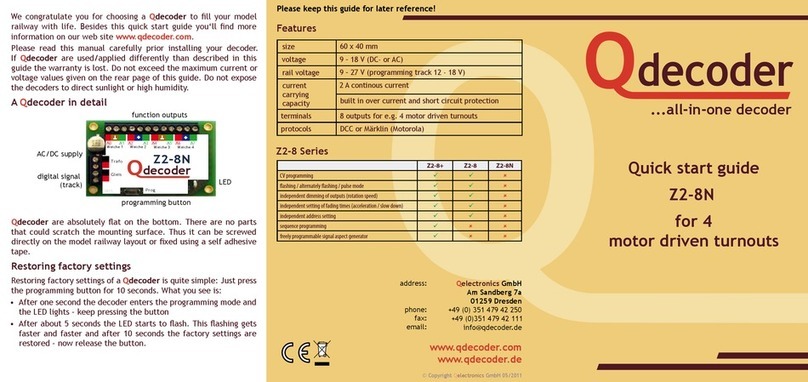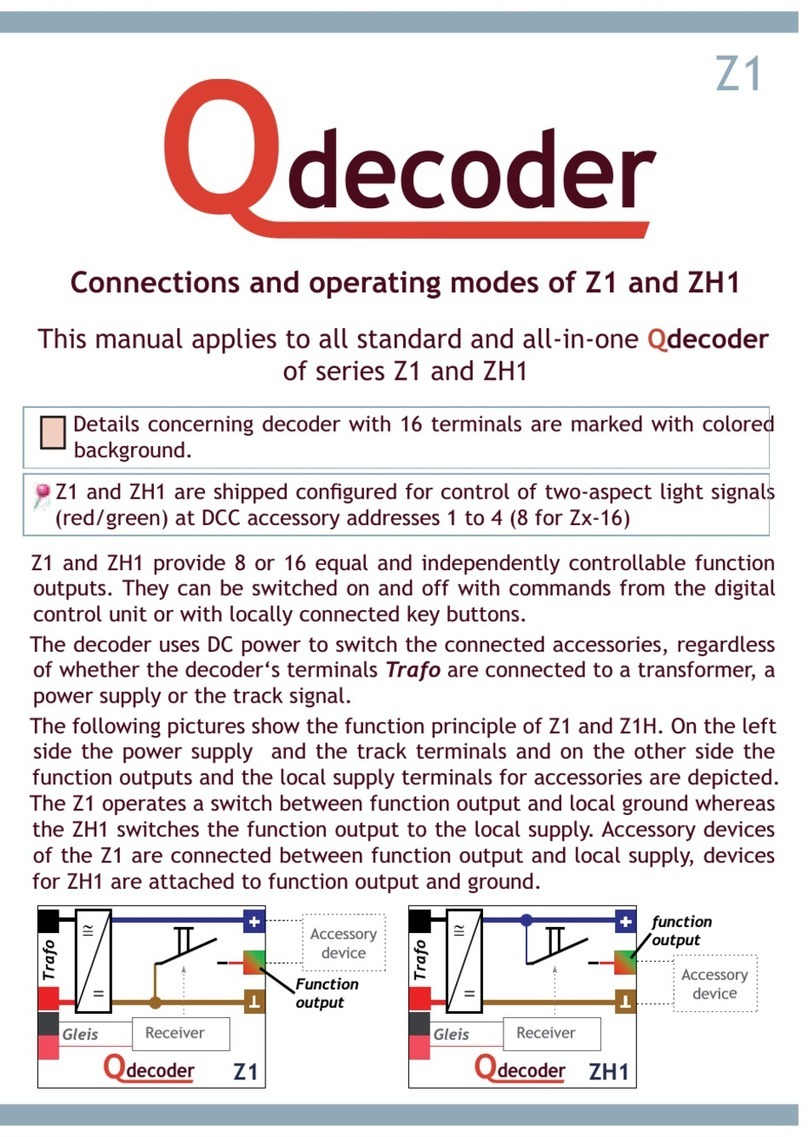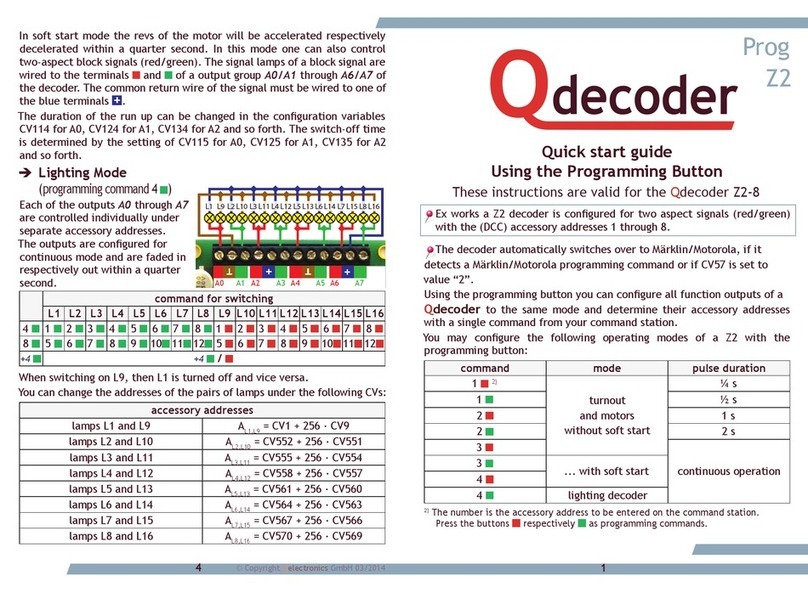Confi guration Step-by-step
1. Select the suitable operating mode from the table.
2. Select the accessory address you wish to assign to the fi rst accessory.
3. Determine the required programming command.
In order to set other accessory addresses than 1 through 4, you have to
add an offset to the address. This offset is determined as follows:
▪ Example 1:
Take the programming command “3 ” from the table.
The decoder shall be programmed to the addresses 201 through 204.
- Deduct 1 from desired address: 201 - 1 = 200
- Add the address of the programming command: 200 + 3 = 203
- Required command: “203 ”
▪ Example 2:
Programming command as per the manual: “4 ”.
The decoder shall be programmed to the addresses 17 through 24.
17 - 1 + 4 = 20 Programming command “20 ”
4. Press the programming button Prog of the decoder and hold it down
for about one second, until the LED lights up continuously. Now release
the button again. The LED remains lit indicating that the decoder has
switched over from normal operating mode into programming mode.
Terminate the programming mode by pressing the button briefl y.
5. Send the determined programming command with your command station.
6. Successful programming is indicated by the extinguishing LED. The
decoder changes over into the newly set operating mode.
Now you can change the operating mode, the addresses as well as the
other properties of the function outputs (e.g. dimming or blinking) for
each connected device by CV programming.
Turnouts / Motors on two Function Outputs
(
programming command 1
,
2
,
3
)
Motors with Soft Start
(
programming command 4
)
You may connect motorised (drawing
on the right) or magnetic drives
simultaneously to the decoder.
The motor leads are only shown
in principle. For turnout drives of
certain manufacturers the specifi c
wiring is shown in the leafl et
“Eletrical connections of the Z2“.
After programming each turnout can be switched with a push button under
the following accessory address:
programming commands
for pulse durations of address for switching
¼ s ½ s 1 s 2 s 1) 2) T1 T2 T3 T4
1 1 2 2 3 4 1 2 3 4
5 5 6 6 7 8 5678
9 9 10 10 11 12 910 11 12
13 13 14 14 11 16 13 14 15 16
17 17 18 18 19 20 17 18 19 20
+4 / +4
1) Continuous mode with immediate switch-on
2) Continuous mode with soft start
Examples:
• The programming command “19 ”sets the decoder to continuous mode with
the addresses 17 through 24.
• “246 ”: Pulse mode (1 second pulse duration), addresses 245 through 252.
You may change the addresses of the turnouts under the following CVs:
accessory addresses
turnout 1 AW1 = CV1 + 256 · CV9
turnout 2 AW2 = CV555 + 256 · CV554
turnout 3 AW3 = CV561 + 256 · CV560
turnout 4 AW4 = CV567 + 256 · CV566
Example: Write the value 700 /256 = 2 in CV567 and the value 700 - (2 · 256) = 188 in
CV566 in order to program turnout 4 to address 700.
The operating mode „Turnouts in continuous mode“ is suitable for turnout
drives with end position contact. Other types of turnouts must be controlled
in pulse mode. In most cases the shortest pulse duration is adequate.
Simply set a longer pulse duration should the turnout not work reliably.
After programming each turnout can be controlled with a push button under
the following accessory address:
You may change the duration of the switch pulse with the programming
command. Then you can simultaneously set the time with the CVs 3 through
6 for two function outputs each from A0 through A7 to a maximum of
2.55 seconds. In CV117/CV116 you can change the switching time for A0
independent of the time set for A1 (CV127/CV126). (CV137/CV136 for A2,
and so forth up to CV277/CV276 for A15). The maximum possible time here
is just under 11 minutes.
In soft start mode the revs of the motor will be accelerated resp. decele-
rated in a quarter second. In this mode one can also control two-aspect
block signals (red/green). The signal lamps of a block signal are wired to
the terminals and of a output group A0/A1 through A6/A7 of the
decoder. The common return wire of the signal must be wired to one of the
blue terminals .
The duration of the run up can be changed in the confi guration variables
CV114 for A0, CV124 for A1, CV134 for A2 and so forth. The switch-off time
is determined by the setting of CV115 for A0, CV125 for A1, CV135 for A2
and so forth.
Wei/Sig 1
A0 A1
Wei/Sig 2
A2 A3
Wei/Sig 3
A4 A5
Wei/Sig 4
A6 A7
2011






















